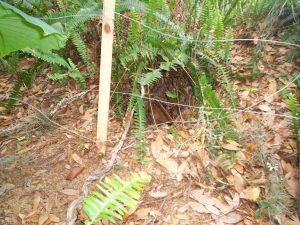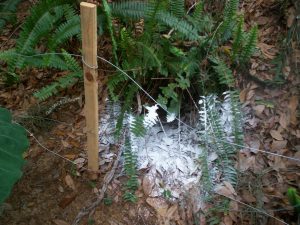 I rarely get the opportunity to do ‘live trapping’ in my business. Usually by the time I explain the ins and outs of the process and then tell my prospective client the cost, I get the “thanks for coming” handshake and I’m off. I figure I’m just too descriptive with ‘how to do it’ that they in turn become a ‘do it yourself pest control’ operation.
I rarely get the opportunity to do ‘live trapping’ in my business. Usually by the time I explain the ins and outs of the process and then tell my prospective client the cost, I get the “thanks for coming” handshake and I’m off. I figure I’m just too descriptive with ‘how to do it’ that they in turn become a ‘do it yourself pest control’ operation.
I got to work on my sales pitch.
Well I’ve recently discovered a burrow in my yard and thought I’d take this chance to show you how it’s done. I don’t know exactly what it is yet (but I have my suspicions) and I’m not sure if it will take one day or 10. If I fail, which does happen to a lot of people, I promise not to get out the shotgun out of frustration. At that point we’ll continue with other options and there are a few of them.
I have some manmade hills on my property with 1000’s of ferns planted on them, this provides a beautiful natural privacy fence to the back yard and now unfortunately it also has allowed a critter to move in. I’ve recently had to put wire around the ferns because my new puppies were ruining the ferns in very short-order. I didn’t notice any holes then so I figure this new resident has only been there a month or so. The only way I was alerted to the hole was my pups that are very well mannered would not leave this area alone constantly barking and sniffing.
beautiful natural privacy fence to the back yard and now unfortunately it also has allowed a critter to move in. I’ve recently had to put wire around the ferns because my new puppies were ruining the ferns in very short-order. I didn’t notice any holes then so I figure this new resident has only been there a month or so. The only way I was alerted to the hole was my pups that are very well mannered would not leave this area alone constantly barking and sniffing.
You may have similar landscaping or perhaps your home is elevated and the critter has dug to gain access to his new, roomy ground level condo. Either way we’ll go through step by step and hopefully help you out.
Determine what it is you are trying to trap. This process is often left out of trapping but it is vital to ensure quickest results. Knowing what you have will determine what type of bait you use. An Armadillo for example may not be the least bit interested in your sardine snack you baited your trap with thinking you had a raccoon. You can also determine the size of the trap you need based on this and that could be all the difference in the world to catching your critter. Big animals can’t fit in small traps.
 To verify what you have you have a couple of options; if you visually see it of course that’s all you’ll need. Most animals of this sort however come out at night to the wee hours of the morning; if you’re not up then you may never know. To determine your critter, simply put talcum or baby powder at the entry. The next day you should be able to see some tracks that will clue you in to what you have. If you don’t see tracks in the first day or two, check for a secondary hole that they may be using.
To verify what you have you have a couple of options; if you visually see it of course that’s all you’ll need. Most animals of this sort however come out at night to the wee hours of the morning; if you’re not up then you may never know. To determine your critter, simply put talcum or baby powder at the entry. The next day you should be able to see some tracks that will clue you in to what you have. If you don’t see tracks in the first day or two, check for a secondary hole that they may be using.
From there it’s a simple process of matching the tracks up to identify the problem. This can be done on line or a book from your library.
Before I get too far I’ll stop here and we’ll pick this up tomorrow with ‘my track’ results. So make sure to drop back in and feel free to comment any and all suggestions you might have regarding the live trapping of animals. Or if you have any stories, humorous or exasperating please share them. I’ll be happy to post them in this series.




